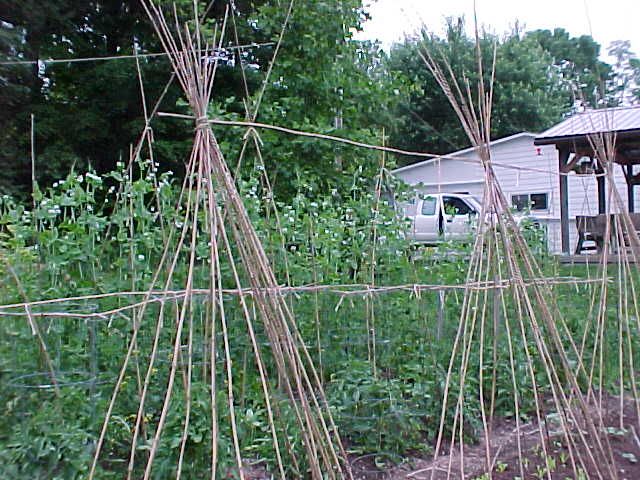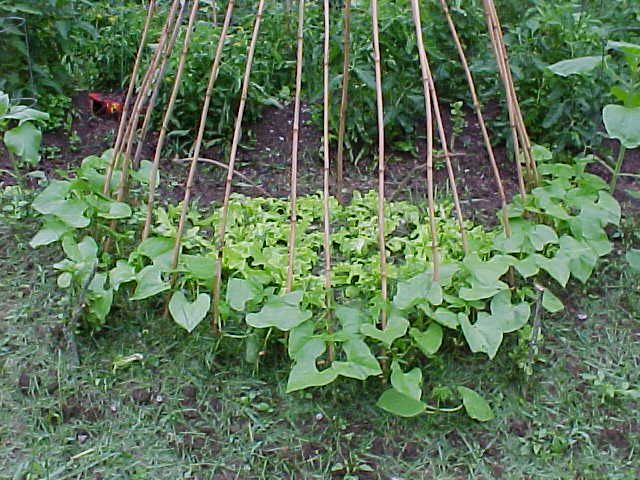|
|
Post by blueadzuki on Sept 16, 2014 8:27:43 GMT -5
|
|
|
|
Post by kyredneck on Sept 16, 2014 9:59:08 GMT -5
I did a brief search with no results; has anyone here grown the shade tolerant 'Withner's White Cornfield Bean' that Carol Deppe grows? It seems that one would carry some desirable genes to incorporate into a landrace.
|
|
|
|
Post by kyredneck on Sept 16, 2014 9:59:33 GMT -5
Here's some photos of some other 'arbors' I've used with great success:



We're located about a mile from the KY river and I used to cut river cane to build the slanted teepees; lettuce grows very well in the shade of these also. It's a shame I don't have any photos with them covered over and hanging with beans. But I do very much like the idea of utilizing the cattle panel units in lieu of the teepees if for no other reason to spare the river cane because it is actually getting more scarce; fishermen cut a lot of them to use as bank mounted 'jigger poles' for channel and flathead catfish.
[add]
The arrangement in the first photo yielded a bumper crop of Goose beans (about 12 years ago), we canned all the beans we wanted and then let them go for several messes of shellies and then got 5-7 ibs. of dry beans for soup beans and seed. I vacuumed packed and kept in the refrigerator around 2 lbs. of seed which I used some this year with about 90% germination (guessing). I guess I need to get more scientific and start keeping written records. Anyhoo, this project was a huge success, I'm still reaping rewards from it.
|
|
|
|
Post by flowerweaver on Sept 16, 2014 13:57:30 GMT -5
I don't know what kind of cane grows in your river, but the one here is introduced and considered invasive. The river authority condones cutting it. That said, if it's useful to you then it's good not to decimate a resource.
|
|
|
|
Post by raymondo on Sept 16, 2014 17:45:36 GMT -5
The arbors all look great. I especially like the idea of using them to shade lettuce.
|
|
|
|
Post by kyredneck on Sept 17, 2014 4:31:47 GMT -5
FYI: "...."I say I'm trying to put the cane back in Cane-tucky," he said, affecting a pretty good Kentucky accent for an Englishman. When the first white explorers came to Kentucky in the mid-1700s, cane was abundant, growing as high as 20 feet in dense forests called canebrakes. Cane was then fairly common in river bottomland across the South. But what surprised explorers about the Inner Bluegrass region around Lexington was that cane also flourished in grassy upland savannahs dotted with centuries-old burr oak, blue ash and other giant hardwood trees. "Here is great plenty of fine cane, on which the cattle feed and grow fat," traveler John Filson wrote in his 1784 book, The Discovery, Settlement and Present State of Kentucke. "There are many cane brakes so thick and tall that it is difficult to pass through them." Cane flourished here because of the phosphorus-rich limestone soil. Campbell estimates that as much of 10 percent of Central Kentucky was once covered in cane. Buffalo herds ate and took shelter in it. Native peoples used it to make everything from baskets to arrow shafts. But cane has been disappearing for two centuries: settlers cleared it, livestock ate it, construction crews dug it up and plant species from Europe and Asia choked it out. "It's about 99 percent gone," ...." www.kentucky.com/2012/09/04/2322854/tom-eblen-effort-to-restore-native.html |
|
|
|
Post by kyredneck on Sept 17, 2014 7:00:20 GMT -5
Kyredneck, From long experience I will tell you that onions hate beans. Never plant them together. However I have had grand luck with beans and lettuce or onions and lettuce. Love the trellis. I think they are great for making shade on one side which makes for better lettuce. I went through an entire farm of runners in Italy that you could stroll through while drinking wine. It was a treat. Don't know how it happened but I totally missed your post till just now, it's like it popped up out of nowhere.
Thank you much for that info about beans and onions, I honestly didn't know that. It was actually an afterthought on my part to interplant the onions with the beans because I had some bulbs left over from early Spring planting, and it was also a 'see what happens venture'; would the bulbs become scallions before the shade took over? No, they did not.
Italy I'm fascinated about, and France, because I'm a foodie AND a gardener and I love the cuisines and the cultivars from both places, a lot. My youngest SIL was stationed in Italy w/173rd Airborne and he is always singing the praises of their food and wine.
|
|
|
|
Post by 12540dumont on Oct 1, 2014 21:16:23 GMT -5
Kyre, Is this Arundo or another type of cane? Thanks for the info!
|
|
|
|
Post by kyredneck on Oct 1, 2014 22:26:12 GMT -5
|
|
|
|
Post by kyredneck on Oct 1, 2014 23:15:29 GMT -5
Arundinaria gigantean
"Arundinaria gigantea is a species of bamboo known by the common names giant cane (not to be confused with Arundo donax) and river cane. It is native to the United States, where it occurs in the south-central and southeastern states as far west as Texas and as far north as New York.... Canebrakes were once a common feature of the landscape in the southeastern United States, but today it is an endangered ecosystem.... Canebrakes declined after European settlement of the American southeast. Factors involved in the decline include the introduction of livestock such as cattle, which eagerly graze on the leaves. The cane was considered a good forage for the animals until overgrazing began to eliminate canebrake habitat.[1] Other reasons for the decline include the conversion of the land for agriculture,[6] and fire suppression...."
|
|
|
|
Post by flowerweaver on Oct 2, 2014 9:36:02 GMT -5
What we have here is Arundo donax, called Carrizo Cane.
|
|
|
|
Post by kyredneck on Oct 2, 2014 13:37:25 GMT -5
Dumb me, I didn't realize Arundinaria and Arundo were two different genus till my last post. Oh well, learned something. :-)
|
|
|
|
Post by 12540dumont on Oct 2, 2014 20:26:19 GMT -5
The Arundo donax is the invasive species. Clogs river channels...not native to the U.S. Glad you have a native one that's useful. One of these days, I'll have bamboo. It's out there, it just is not running, jumping and overrunning everything like folks warned me about. In the meantime, I have a bean house.
|
|
|
|
Post by steev on Oct 2, 2014 21:22:58 GMT -5
What's that cane that grows out in the valley, like around Stockton/Modesto?
|
|
|
|
Post by kyredneck on Oct 3, 2014 7:20:05 GMT -5
"....I have a bean house."
What's that? Got a picture?
|
|